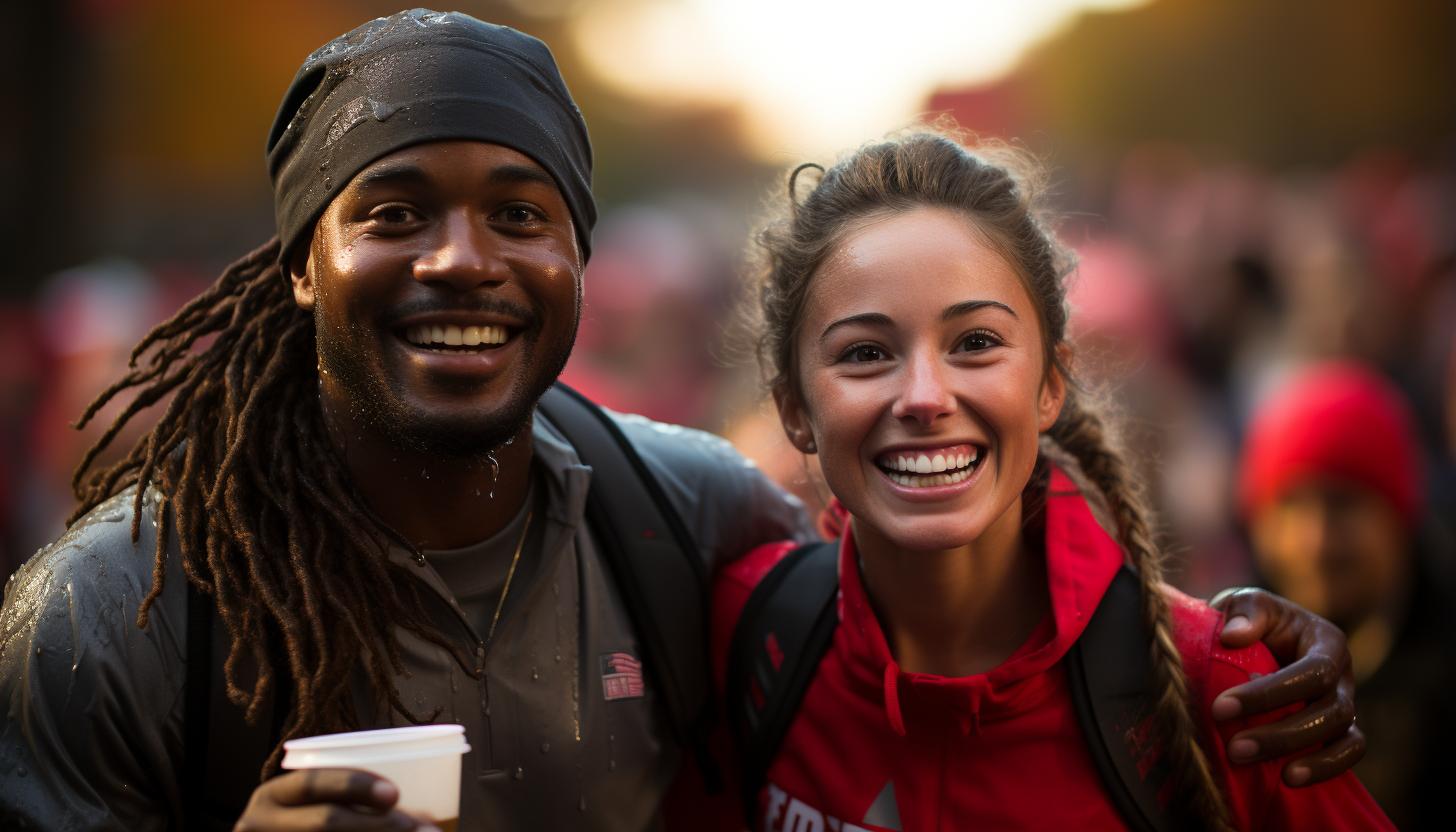Tips for Fueling During Long Runs and Races

Are you ready to conquer long runs and races with a fueled-up body? In this article, we’re going to equip you with tips that will help you power through those miles.
Choosing the right fueling strategy, timing your intake effectively, understanding the importance of hydration, and incorporating electrolytes for endurance are just a few topics we’ll cover.
So lace up your shoes, grab your water bottle, and get ready to optimize your performance on the road or trail.
Choosing the Right Fueling Strategy

To choose the right fueling strategy, you’ll need to consider your individual needs and preferences. When it comes to long runs and races, finding alternatives to traditional fuel sources can be beneficial. Many runners rely on energy gels or chews, but these may not work for everyone. Experiment with different options like sports drinks, real food such as bananas or peanut butter sandwiches, or even homemade energy bars. It’s important to find what works best for you in terms of taste, convenience, and how easily it sits in your stomach.
Managing digestion is another key aspect of fueling during long runs and races. You don’t want to consume too much that might lead to digestive issues like cramping or bloating. On the other hand, not fueling enough can result in low energy levels and hitting the dreaded ‘wall.’ Start by consuming small amounts of fuel at regular intervals throughout your run or race rather than trying to eat a large amount all at once.
Incorporating a variety of carbohydrates into your fueling strategy can also help provide sustained energy. Aim for a mix of simple carbs (like fruit) for quick energy boosts and complex carbs (like whole grains) for longer-lasting endurance.
Transitioning into the next section about timing your fueling, it’s important to remember that the timing of when you consume your fuel is just as crucial as what you consume.
Timing Your Fueling

When timing your fueling during long runs and races, it’s important to listen to your body’s signals. Your body needs a constant supply of energy to perform at its best, so fueling frequency is key. But what exactly does that mean? Let’s break it down:
| Fueling Frequency | Fueling Sources | Timing |
|---|---|---|
| Every 45 minutes | Energy gels | During |
| Every hour | Sports drinks | Before |
| Every 90 minutes | Banana | After |
By following this table, you can ensure that you’re giving your body the fuel it needs when it needs it. Fueling every 45 minutes with energy gels provides a quick burst of carbohydrates for immediate energy. Sports drinks, consumed every hour before your run or race, replenish electrolytes lost through sweat and provide sustained energy. And don’t forget about post-run fueling! Eating a banana after every 90 minutes helps restore glycogen levels and aids in muscle recovery.
Understanding the importance of hydration goes hand in hand with proper fueling. Stay tuned for our next section on how to stay hydrated during long runs and races!
Understanding the Importance of Hydration

Make sure you understand how important it is to stay hydrated during your runs and races. Proper hydration plays a crucial role in optimizing performance, preventing fatigue, and reducing the risk of dehydration-related complications.
Here’s what you need to know about the science behind hydration and some common mistakes to avoid:
– Water vs. sports drinks: While plain water can be sufficient for shorter runs, sports drinks containing electrolytes and carbohydrates are recommended for longer races to replenish essential nutrients lost through sweat.
– Pre-hydration: Start hydrating well before your run or race. Aim to consume 16-20 ounces of fluids two to three hours beforehand, followed by an additional 8-10 ounces just before starting.
– During-exercise hydration: Sip on fluids every 15-20 minutes during your run or race. A general guideline is to drink around 6-8 ounces every hour, but individual needs may vary based on factors such as weather conditions and personal sweat rates.
– Monitoring urine color: Pay attention to the color of your urine as an indicator of hydration status. Pale yellow indicates adequate hydration, while dark yellow suggests dehydration.
– Overhydration caution: Avoid excessive fluid intake, as it can lead to hyponatremia (low sodium levels) which can be dangerous. Drink when thirsty and monitor signs of dehydration rather than forcing excessive fluids.
Understanding the importance of staying properly hydrated during your runs and races will help you perform at your best and ensure a safe experience on the road or trail.
Incorporating Electrolytes for Endurance

Incorporating electrolytes into your hydration routine is crucial for maintaining endurance during your runs and races. Electrolyte replenishment plays a vital role in preventing muscle cramps and optimizing performance.
During long runs or races, you lose electrolytes through sweat, which can lead to an imbalance in your body’s electrolyte levels. This imbalance can result in muscle cramping, fatigue, and decreased performance.
Electrolytes are minerals that carry electrical charges and help regulate various bodily functions. The most important electrolytes for athletes are sodium, potassium, magnesium, and calcium. These minerals work together to maintain fluid balance, nerve function, muscle contractions, and energy production.
To avoid cramping and improve endurance, it is essential to replenish these electrolytes during prolonged exercise sessions. Sports drinks containing electrolytes are a convenient option as they provide a balanced mix of fluids and essential minerals. You can also consider consuming natural sources of electrolytes such as bananas (potassium), dark leafy greens (magnesium), or dairy products (calcium).
Remember to drink plenty of fluids throughout your run or race to stay properly hydrated. Aim to consume around 16-24 ounces of fluid per hour of exercise. Additionally, be mindful of the weather conditions as higher temperatures may increase sweat rates and the need for more frequent electrolyte replenishment.
Experimenting With Different Fueling Options

Experimenting with different fueling options can help you find the best strategy to optimize your performance during endurance activities. It’s important to understand what works best for your body and what keeps you fueled and energized throughout long runs and races.
Here are some options worth exploring:
– Trying new gels: Gels are a popular choice among runners due to their convenience and quick absorption. Experiment with different brands and flavors to find the one that suits your taste buds.
– Energy bars for long runs: Energy bars provide a combination of carbohydrates, protein, and fats, making them a great option for sustained energy during longer runs. Look for bars that have a good balance of nutrients without being too heavy on the stomach.
– Exploring liquid fuel options: Liquid fuels such as sports drinks or homemade electrolyte mixes can be beneficial during intense workouts or races lasting over an hour. They help replenish electrolytes lost through sweat while providing hydration.
– Portable snacks for races: When it comes to races, portability is key. Consider carrying small snacks like bananas, granola bites, or nut butter packets that offer a quick energy boost without weighing you down.
Conclusion
So there you have it, my friend. You’ve reached the end of this article and hopefully gained some valuable insight into fueling during long runs and races.
Remember, choosing the right fueling strategy is crucial for your performance. Timing your fueling can make all the difference in maintaining energy levels. And let’s not forget about hydration and electrolytes – they are the unsung heroes of endurance!
Don’t be afraid to experiment with different fueling options until you find what works best for you. Happy running!






